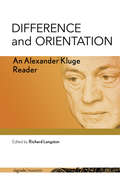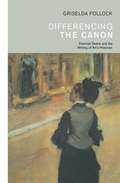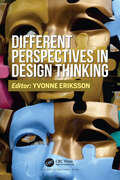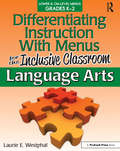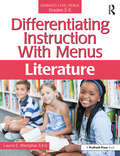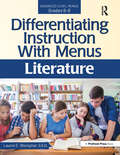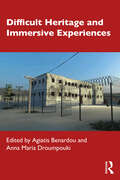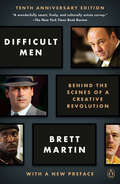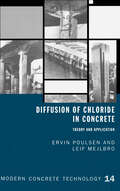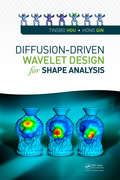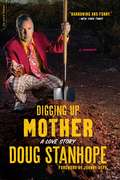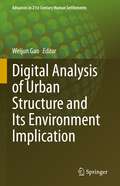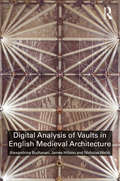- Table View
- List View
Difference and Orientation: An Alexander Kluge Reader (signale|TRANSFER: German Thought in Translation)
by Alexander KlugeAlexander Kluge is one of contemporary Germany's leading intellectuals and artists. A key architect of the New German Cinema and a pioneer of auteur television programming, he has also cowritten three acclaimed volumes of critical theory, published countless essays and numerous works of fiction, and continues to make films even as he expands his video production to the internet. Despite Kluge's five decades of work in philosophy, literature, television, and media politics, his reputation outside of the German-speaking world still largely rests on his films of the 1960s, 70s, and 80s. With the aim of introducing Kluge's heterogeneous mind to an Anglophone readership, Difference and Orientation assembles thirty of his essays, speeches, glossaries, and interviews, revolving around the capacity for differentiation and the need for orientation toward ways out of catastrophic modernity. This landmark volume brings together some of Kluge's most fundamental statements on literature, film, pre- and post-cinematic media, and social theory, nearly all for the first time in English translation. Together, these works highlight Kluge's career-spanning commitment to unorthodox, essayistic thinking.
Difference, Sameness and DNA: Investigations in Critical Art and Science (Palgrave BioArt)
by Paul VanouseThis book chronicles over two decades of critical, artistic investigations by Paul Vanouse. His bio-media artwork utilizes the tools of the life sciences reflexively, to challenge tropes and cultural politics surrounding DNA, biotechnology, and life itself. DNA has been called a “Truth Machine”, “God’s Blueprint”, the “Code of Codes” and the “Book of Life”. Vanouse’s work explores questions at the heart of such evocative metaphor and hyperbole: how does DNA link us together, how does it differentiate us and how are the grand metaphors, which grant DNA complete centrality, misconstruing the complexity of life. Furthermore, how do technologies of genetic typing and identification fit within a broader cultural and political history of difference making, particularly the construction of race. Melding critical theory, artist’s manifesto, participatory observation and histories of the sciences, this book offers insight into both an artistic practice and the bio-techno-sciences it interrogates.
Differencing the Canon: Feminism and the Writing of Art's Histories (Re Visions Ser.)
by Griselda PollockIn this major book, Griselda Pollock engages boldly in the culture wars over `what is the canon?` and `what difference can feminism make?` Do we simply reject the all-male line-up and satisfy our need for ideal egos with an all women litany of artistic heroines? Or is the question a chance to resist the phallocentric binary and allow the ambiguities and complexities of desire - subjectivity and sexuality - to shape the readings of art that constantly displace the present gender demarcations?
Different Engines: Media Technologies From Latin America (Routledge Research in Design, Technology and Society)
by Andrés BurbanoDifferent Engines investigates the emergence of technologies in Latin America to create images, sounds, video games, and physical interactions. The book contributes to the construction of a historiographical and theoretical framework for understanding the work of creators who have been geographically and historically marginalized through the study of five exemplary and yet relatively unknown artifacts built by engineers, scientists, artists, and innovators. It offers a broad and detailed view of the complex and sometimes unlikely conditions under which technological innovation is possible and of the problematic logics under which these innovations may come to be devalued as historically irrelevant. Through its focus on media technologies, the book presents the interactions between technological and artistic creativity, working towards a wider understanding of the shifts in both fields that have shaped current perceptions, practices, and design principles while bringing into view the personal, social, and geopolitical singularities embodied by particular devices. It will be an engaging and insightful read for scholars, researchers, and students across a wide range of disciplines, such as media studies, art and design, architecture, cultural history, and the digital humanities.
Different Perspectives in Design Thinking
by Yvonne ErikssonGlobalization and digitalization are buzz words in contemporary society. They affect both our private and our professional lives. Society has become more diverse with easier access to information and to virtual platforms that gives us opportunity to be in touch with colleagues, friends, family, etc. at any time. A complex environment is emerging wherein internet of things and big data are being integrated with products, production systems, healthcare, and daily activity and play an important part in decision making. This has an impact on future designs and the role of designers. Responsible designers with a holistic perspective are needed.The book highlights several aspects of design thinking such as Information Design and Critical Design. The meaning of culture, gender and disabilities are also discussed. The functions of Information Design are changing from ‘showing the way’, instruction manuals and graphic design. It will affect among others, healthcare technology, smart products and Industry 4.0. Design thinking perspective that includes users from the entire chain and from the producer to the end user of the product or service, is needed. This will also require gender and culture issues to be taken into consideration in designing products and services. Design thinking methods and critical aspects of design will contribute to an inclusive society.
Differentiating Instruction With Menus for the Inclusive Classroom: Language Arts (Grades 3-5)
by Laurie E. WestphalDifferentiating Instruction With Menus for the Inclusive Classroom: Language Arts for grades 3-5 offers teachers everything they need to create a student-centered learning environment based on choice. This book provides five different types of menus that students can use to select exciting products that they will develop so teachers can assess what has been learned-instead of using a traditional worksheet format. Topics addressed include genres, popular novels, and mechanics. Differentiating Instruction With Menus for the Inclusive Classroom: Language Arts provides numerous types of leveled menus that lower and on-level elementary-aged students can use to demonstrate learning through a method of their choice. Menus with similar formats but geared towards varying ability levels allow teachers to differentiate easily. Using the creative and challenging choices found in Three Shape menus, Tic-Tac-Toe menus, List menus, 2-5-8 menus, and Game Show menus, students will look forward to sharing their newfound knowledge throughout the year. Also included are specific guidelines for products, rubrics for assessing student products, and teacher introduction pages for each menu. This is a must-have for any teacher wanting to differentiate for a wide range of learners!Grades 3-5
Differentiating Instruction With Menus for the Inclusive Classroom: Language Arts (Grades 6-8)
by Laurie E. WestphalDifferentiating Instruction With Menus for the Inclusive Classroom: Language Arts for grades 6-8 offers teachers who have multiple ability levels in one classroom everything they need to create a student-centered learning environment based on choice. For each topic covered, there are two menus that look similar but contain differentiated content: one menu for students working on grade level and the other for students working below grade level. Using the creative, challenging choices found in Tic-Tac-Toe menus, List menus, 2-5-8 menus, and Game Show menus, students will demonstrate their knowledge with unique, exciting products. Also included are specific guidelines for products, assessment rubrics, and teacher introduction pages for each menu. These menus can also be used in conjunction with the Differentiating Instruction With Menus series (for students working above grade level) for three tiers of complementary menus.Grades 6-8
Differentiating Instruction With Menus for the Inclusive Classroom: Language Arts (Grades K-2)
by Laurie E. WestphalDifferentiating Instruction With Menus for the Inclusive Classroom: Language Arts for grades K-2 offers teachers everything needed to create a student-centered learning environment based on choice. This book provides seven different types of menus that students can use to select exciting products that they will develop so teachers can assess what has been learned—instead of using a traditional worksheet format. Topics addressed include genres, books, and mechanics. Differentiating Instruction With Menus for the Inclusive Classroom: Language Arts provides numerous types of leveled menus that lower and on-level primary-age students can use to select exciting products to demonstrate learning. Menus with similar formats but geared toward varying ability levels allow teachers to differentiate easily. Using the creative and challenging choices found in Meal menus, Tic-Tac-Toe menus, Target-Based List menus, 2-5-8 menus, Give Me 5 menus, Three-Shape menus, and Pick 3 menus, students will look forward to sharing their newfound knowledge throughout the year. Also included are specific guidelines for products, rubrics for assessing student products, and teacher introduction pages for each menu. This is a must-have for any teacher wanting to differentiate for a wide range of learners!Grades K-2
Differentiating Instruction With Menus: Literature (Grades 3-5)
by Laurie E. WestphalDifferentiating Instruction With Menus: Literature (Grades 3-5):
Differentiating Instruction With Menus: Literature (Grades 6-8)
by Laurie E. WestphalDifferentiating Instruction With Menus: Literature (Grades 6-8):
Differentiating Instruction With Menus: Literature (Grades 9-12)
by Laurie E. WestphalDifferentiating Instruction With Menus: Literature (Grades 9-12):
Differentiating with Graphic Organizers: Tools to Foster Critical and Creative Thinking
by Patti DrapeauGraphic organizers have proven to be successful tools for helping students develop their critical and creative thinking skills. This research-based resource shows how graphic organizers can improve teaching practices, help differentiate instruction in the classroom, and raise learning outcomes for all students, including English language learners and students with learning disabilities.The author presents graphic organizers for nine types of thinking processes based on Bloom's taxonomy and offers examples of how to apply the graphic organizers in different subject areas and grade levels. This hands-on guide demonstrates how teachers can:Promote the critical thinking processes of assuming, inferring, analyzing, prioritizing, and judgingEncourage the creative thinking processes of brainstorming, connecting, creating, and elaboratingModify graphic organizers or create their own to meet individual learning needsWith assessment rubrics for providing quality feedback included, Differentiating With Graphic Organizers addresses ways to promote and build students’ creative reasoning, communication, and problem-solving skills and make the learning process a success.
Difficult Death, Dying and the Dead in Media and Culture
by Sharon Coleclough Bethan Michael-Fox Renske VisserThis book responds to a growing interest in death, dying and the dead within and beyond the field of death studies. The collection defines an understanding of ‘difficult death’ and examines the differences between death, dying and the dead, as well as exploring the ethical challenges of researching death in mediated form. The collection is attendant to the ways in which difficult deaths are imbricated in power structures both before and after they become mediatised in culture. As such, the work navigates the many political and social complexities and inequalities – what might be deemed the difficulties – of death, dying and the dead. The book seeks to expand understandings of the difficulty of death in media and culture through a wide range of chapters from different contexts focused on literature, film, television, and in online environments, as well as several chapters examining news reportage of difficult deaths.
Difficult Heritage and Immersive Experiences
by Agiatis Benardou and Anna Maria DroumpoukiDifficult Heritage and Immersive Experiences examines the benefits involved in designing and employing immersive technologies to reconstruct difficult pasts at heritage sites around the world. Presenting interdisciplinary case studies of heritage sites and museums from across a range of different contexts, the volume analyzes the ways in which various types of immersive technologies can help visitors to contextualize and negotiate difficult or sensitive heritage and traumatic pasts. Demonstrating that some of the most creative applications of immersive experiences appear in and at museums and heritage sites, the book showcases how immersive technologies offer the possibility of confronting and disputing presumptions and prejudices, triggering responses, delivering new knowledge, initiating dialogue and challenging preexistingnotions of collective identity. The book provides a conceptual, as well as a hands-on, approach to understanding the use of immersive technologies at sensitive sites around the globe. Difficult Heritage and Immersive Experiences is essential reading for researchers and students who are interested in, or engaged in the study of, cultural heritage, memory, history, politics, dark tourism, design and digital media or immersive technologies. The book will also be of interest to museum and heritage practitioners.
Difficult Men: Behind the Scenes of a Creative Revolution
by Brett MartinIn the late 1990s and early 2000s, a wave of TV shows, first on premium cable channels like HBO and then basic cable networks like FX and AMC, dramatically stretched television's inventiveness, emotional resonance and ambition. Shows such as The Wire, The Sopranos, Mad Men, Deadwood, The Shield tackled issues of life and death, love and sexuality, addiction, race and violence. This revolution happened at the hands of a new breed of auteur: the all-powerful writer-show runner. These were men nearly as complicated, idiosyncratic, and "difficult" as the conflicted protagonists that defined the genre. Given the chance to make art in a maligned medium, they fell upon the opportunity with unchecked ambition. Difficult Men features extensive interviews with all the major players, including David Chase (The Sopranos), David Simon and Ed Burns (The Wire), Matthew Weiner and Jon Hamm (Mad Men), David Milch (NYPD Blue, Deadwood), and Alan Ball (Six Feet Under), in addition to dozens of other writers, directors, studio executives and actors. Martin takes us behind the scenes of our favourite shows, delivering never-before-heard story after story and revealing how TV has emerged from the shadow of film to become a truly significant and influential part of our culture.
Diffracting Digital Images: Archaeology, Art Practice and Cultural Heritage
by Ian Dawson Andrew Meirion Jones Paul Reilly Louisa MinkinDigital imaging techniques have been rapidly adopted within archaeology and cultural heritage practice for the accurate documentation of cultural artefacts. But what is a digital image, and how does it relate to digital photography? The authors of this book take a critical look at the practice and techniques of digital imaging from the stance of digital archaeologists, cultural heritage practitioners and digital artists. Borrowing from the feminist scholar Karen Barad, the authors ask what happens when we diffract the formal techniques of archaeological digital imaging through a different set of disciplinary concerns and practices. Diffracting exposes the differences between archaeologists, heritage practitioners and artists, and foregrounds how their differing practices and approaches enrich and inform each other. How might the digital imaging techniques used by archaeologists be adopted by digital artists, and what are the potentials associated with this adoption? Under the gaze of fine artists, what happens to the fidelity of the digital images made by archaeologists, and what new questions do we ask of the digital image? How can the critical approaches and practices of fine artists inform the future practice of digital imaging in archaeology and cultural heritage? Diffracting Digital Images will be of interest to students and scholars in archaeology, cultural heritage studies, anthropology, fine art, digital humanities, and media theory.
Diffracting New Materialisms: Emerging Methods in Artistic Research and Higher Education
by Annouchka Bayley Jj ChanThis edited book considers the vital position of artistic research in the landscapes and ecosystems of new materialism(s) and post-humanism(s), in and for higher education. The book aims to satisfy an urgent desire for change in the ways we link artistic and critical research practices, asking what new ways of thinking and creating for twenty-first century artistic and educational contexts we need in order to address the kinds of global complexities we face. Organised around five key themes including fictioning, reading, embodying, inhabiting and folding, the book acts as an entry point for academics, artists and scholar-practitioners to participate in the shaping of new forms of artistic research and practice that are relevant, participatory, and that urgently address the kinds of complex issues emergent in our twenty-first century context. In doing so, the book makes a key contribution to the development of emerging inter- and transdisciplinary artistic research practices across a range of fields, responding to the question - what kinds of research and practice worlds do we wish to create in times of urgency, crisis and complexity?
Diffusion of Chloride in Concrete: Theory and Application
by E. PoulsenThis is a comprehensive and rigorous presentation on chloride ingress in concrete, drawing on test results and field observations as well as mathematical principles. It is written for practising engineers and is also a useful reference for engineering students.
Diffusion-Driven Wavelet Design for Shape Analysis
by Hong Qin Tingbo HouFrom Design Methods and Generation Schemes to State-of-the-Art ApplicationsWavelets are powerful tools for functional analysis and geometry processing, enabling researchers to determine the structure of data and analyze 3D shapes. Suitable for researchers in computer graphics, computer vision, visualization, medical imaging, and geometric modeling
Digging Miami
by Robert S CarrThe pace of change of Miami since its incorporation in 1896 is staggering. The seaside land that once was home to several thousand Tequesta is now congested with roads and millions of people while skyscrapers and artificial lights dominate the landscape.Ironically, Miami's development both continually erases monuments and traces of indigenous people and historic pioneers yet also leads to the discovery of archaeological treasures that have lain undiscovered for centuries. In Digging Miami, Robert Carr traces the rich 11,000-year human heritage of the Miami area from the time of its first inhabitants through the arrival of European settlers and up to the early twentieth century.Carr was Dade County's first archaeologist, later historic preservation director, and held the position at a time when redevelopment efforts unearthed dozens of impressive archaeological sites, including the Cutler Site, discovered in 1985, and the controversial Miami Circle, found in 1998. Digging Miami presents a unique anatomy of this fascinating city, dispelling the myth that its history is merely a century old.This comprehensive synthesis of South Florida's archaeological record will astonish readers with the depth of information available throughout an area barely above sea level. Likewise, many will be surprised to learn that modern builders, before beginning construction, must first look for signs of ancient peoples' lives, and this search has led to the discovery of over one hundred sites within the county in recent years. In the end, we are left with the realization that Miami is more than the dream of entrepreneurs to create a tourist mecca built on top of dredged rock and sand; it is a fascinating, vibrant spot that has drawn humans to its shores for unimaginable years.
Digging Up Mother: A Love Story
by Johnny Depp Doug StanhopeAfter enjoying early success as co-host of The Man Show with Joe Rogan, the past twenty years of Doug Stanhope's career can be seen as a subversive insider attack against the "bro-code" he helped to launch. Following a very singular career arc, Stanhope turned his back on Hollywood and toured relentlessly for years, performing up to 200 shows a year. He's a giant cult comedian with a fiercely loyal audience. His material is abrasive and often offensive, but it also relies on a bullshit-free, hardcore, outraged, truth-telling perspective in the tradition of the late Bill Hicks. Stanhope's memoir is sure to rub many the wrong way, but not without causing fits of uncontrollable laughter in the process.
Digital (Technoscience and Society)
by Debra Mackinnon Ryan Burns Victoria FastIn the contemporary moment, smart cities have become the dominant paradigm for urban planning and administration, which involves weaving the urban fabric with digital technologies. Recently, however, the promises of smart cities have been gradually supplanted by recognition of their inherent inequalities, and scholars are increasingly working to envision alternative smart cities. Informed by these pressing challenges, Digital (In)Justice in the Smart City foregrounds discussions of how we should think of and work towards urban digital justice in the smart city. It provides a deep exploration of the sources of injustice that percolate throughout a range of sociotechnical assemblages, and it questions whether working towards more just, sustainable, liveable, and egalitarian cities requires that we look beyond the limitations of "smartness" altogether. The book grapples with how geographies impact smart city visions and roll-outs, on the one hand, and how (unjust) geographies are produced in smart pursuits, on the other. Ultimately, Digital (In)Justice in the Smart City envisions alternative cities – smart or merely digital – and outlines the sorts of roles that the commons, utopia, and the law might take on in our conceptions and realizations of better cities.
Digital Access and Museums as Platforms (Museums in Focus)
by Caroline Wilson-BarnaoDigital Access and Museums as Platforms draws on interviews with museum practitioners, along with a range of case studies from public and private institutions, in order to investigate the tensions and benefits involved in making cultural collections available using digital technologies. Taking a media and critical studies approach to the museum and raising questions about the role of privately owned search engines in facilitating museum experiences, the book questions who collects what, for whom objects are collected and what purpose these objects and collections serve. Connecting fieldwork undertaken in Australia and New Zealand with the global practices of technology companies, Wilson-Barnao brings attention to an emerging new model of digital ownership and moderation. Considering the synergising of these institutions with media systems, which are now playing a more prominent role in facilitating access to culture, the book also explores the motivations of different cultural workers for constructing the museum as a mediatised location. Digital Access and Museums as Platforms will be of interest to academics and students working in the fields of museum studies, art, culture, media studies and digital humanities. Weighing in on conversations about how technologies are being incorporated into museums, the book should also be useful to practitioners working in museums and galleries around the world.
Digital Analysis of Urban Structure and Its Environment Implication (Advances in 21st Century Human Settlements)
by Weijun GaoThis book provides new information to understand the relationship between urban development and environmental change to the reader. How to create a sustainable and livable urban environment and realize the sustainable development goals (SDGs) of the United Nations (UN) is one of the biggest challenges in this century, even in the next centuries. The covered subject areas of this book aim at finding a way to push SDGs forward by collecting the related knowledge between urban development and its environmental implication. Specifically, the book focuses on UN SDGs 9 (industry, innovation and infrastructure), 11 (sustainable cities and communities), and 13 (climate action). Regarding the SDGs 9, this book assesses urban population mobility, urban ecosystem services, and green infrastructure to address climate change in cities. Regarding the SDGs 11, this book explores the sustainability of urban landscape change associated with urbanization based on a multi-scale perspective. Regarding the SDGs 13, this book explores the issues affecting the development of healthy cities in the context of climate change and possible ways to address them. This book focuses on newer fields related to various forms of urbanization and urban climate. Under different urbanization and development scenarios, the city and built environment are facing new challenges and become a major concern. Better understandings of related physical laws and sustainable technologies are badly needed. This book is a good reference to urban planners, city officials, citizens who are concerned about the city environment, and policymakers, as well as students studying urban structure and environment.
Digital Analysis of Vaults in English Medieval Architecture
by Nicholas Webb Alexandrina Buchanan James HillsonMedieval churches are one of the most remarkable creative and technical achievements in architectural history. The complex vaults spanning their vast interiors have fascinated both visitors and worshippers alike for over 900 years, prompting many to ask: ‘How did they do that?’ Yet very few original texts or drawings survive to explain the processes behind their design or construction. This book presents a ground-breaking new approach for analysing medieval vaulting using advanced digital technologies. Focusing on the intricately patterned rib vaulting of thirteenth and fourteenth century England, the authors re-examine a series of key sites within the history of Romanesque and Gothic Architecture, using extensive digital surveys to examine the geometries of the vaults and provide new insights into the design and construction practices of medieval masons. From the simple surfaces of eleventh-century groin vaults to the gravity-defying pendant vaults of the sixteenth century, they explore a wide range of questions including: How were medieval vaults conceived and constructed? How were ideas transferred between sites? What factors led to innovations? How can digital methods be used to enhance our understanding of medieval architectural design? Featuring over 200 high quality illustrations that bring the material and the methods used to life, Digital Analysis of Vaults in English Medieval Architecture is ideal reading for students, researchers and anyone with an interest in medieval architecture, construction history, architectural history and design, medieval geometry or digital heritage.
